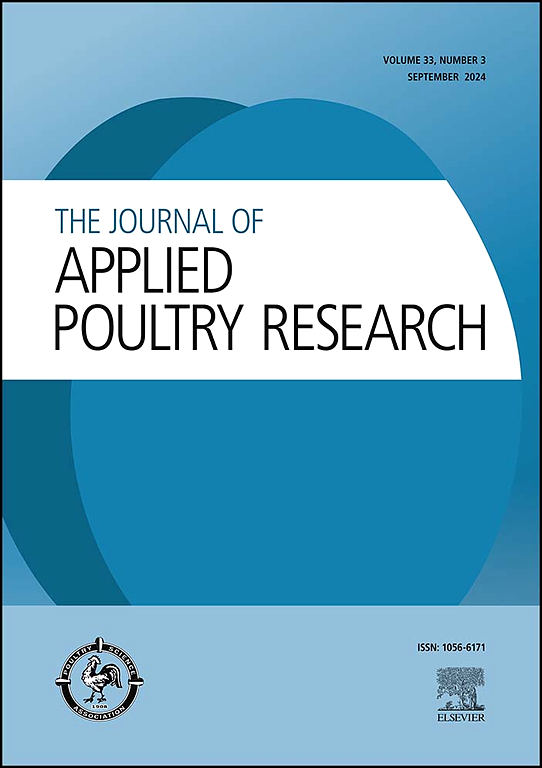Consumers’ acceptance of eggs as a function of hen genotype and rearing system
IF 2
3区 农林科学
Q2 AGRICULTURE, DAIRY & ANIMAL SCIENCE
引用次数: 0
Abstract
The aim of this study was to evaluate consumers’ acceptance of eggs as a function of hen genotype and rearing system. In view of supporting biodiversity safeguard and animal welfare, two Italian dual-purpose breeds (i.e., Bionda Piemontese, BP; Robusta Maculata, RM) and their crossbreeds with the commercial hybrid Sassò (BPxS; RMxS) were considered, reared in two different systems (i.e., enriched cage, C; free-range, F). As a reference, the commercial hybrid Lohmann Brown (L) was included in the experimental design. Eggs for sensory analysis were collected from 59-week-old layers and boiled for presentation to 80 untrained consumers. Panellists were instructed to indicate the liking degree in unstructured 9-point hedonic scales for the following attributes: overall appearance, general aroma, general flavour, yolk colour, texture, and overall liking. Cage-free and organic eggs were bought by 44% and 39% of the respondents, respectively, thus indicating a significant (p < 0.001) attention towards production system and animal welfare. Statistically significant differences (p < 0.05) were detected only for overall appearance, yolk colour, and overall liking. The maximum median score was always obtained for the eggs RMxS reared in F. Eggs from L reared F got the lowest median scores for overall appearance and yolk colour. Considering the overall liking attribute, the significantly most preferred samples (p < 0.05) resulted RM_C (6.60), BPxS_C (5.90), and RMxS_F (6.80). The hen genotype resulted significant (p < 0.05) for yolk colour and overall liking, whereas the rearing system significantly affected (p < 0.05) yolk colour and general aroma.
消费者对鸡蛋的接受程度与母鸡基因型和饲养系统有关
本研究旨在评估消费者对鸡蛋的接受程度与母鸡基因型和饲养系统的关系。为了支持生物多样性保护和动物福利,本研究考虑了两个意大利两用品种(即皮埃蒙特比安达(Bionda Piemontese),BP;罗布斯塔马库拉塔(Robusta Maculata),RM)及其与商品杂交萨索(Sassò)的杂交品种(BPxS;RMxS),并采用两种不同的饲养系统(即笼养,C;散养,F)进行饲养。作为参考,实验设计中还包括商品杂交种 Lohmann Brown(L)。用于感官分析的鸡蛋取自 59 周龄的蛋鸡,煮熟后呈现给 80 位未经培训的消费者。受试者被要求用非结构化的 9 点享乐量表来表示对以下属性的喜欢程度:整体外观、一般香气、一般风味、蛋黄颜色、质地和整体喜欢程度。分别有 44% 和 39% 的受访者购买了无笼养鸡蛋和有机鸡蛋,这表明受访者对生产系统和动物福利的关注度很高 (p < 0.001)。只有在整体外观、蛋黄颜色和整体喜好方面发现了明显的统计学差异(p < 0.05)。F饲养的RMxS鸡蛋的中位数得分最高,而L饲养的F鸡蛋在整体外观和蛋黄颜色方面的中位数得分最低。从总体喜好属性来看,最喜欢的样品(p < 0.05)是 RM_C(6.60)、BPxS_C(5.90)和 RMxS_F(6.80)。母鸡基因型对蛋黄颜色和总体喜好有显著影响(p < 0.05),而饲养系统对蛋黄颜色和总体香味有显著影响(p < 0.05)。
本文章由计算机程序翻译,如有差异,请以英文原文为准。
求助全文
约1分钟内获得全文
求助全文
来源期刊

Journal of Applied Poultry Research
农林科学-奶制品与动物科学
CiteScore
4.10
自引率
10.50%
发文量
80
审稿时长
104 days
期刊介绍:
The Journal of Applied Poultry Research (JAPR) publishes original research reports, field reports, and reviews on breeding, hatching, health and disease, layer management, meat bird processing and products, meat bird management, microbiology, food safety, nutrition, environment, sanitation, welfare, and economics. As of January 2020, JAPR will become an Open Access journal with no subscription charges, meaning authors who publish here can make their research immediately, permanently, and freely accessible worldwide while retaining copyright to their work. Papers submitted for publication after October 1, 2019 will be published as Open Access papers.
The readers of JAPR are in education, extension, industry, and government, including research, teaching, administration, veterinary medicine, management, production, quality assurance, product development, and technical services. Nutritionists, breeder flock supervisors, production managers, microbiologists, laboratory personnel, food safety and sanitation managers, poultry processing managers, feed manufacturers, and egg producers use JAPR to keep up with current applied poultry research.
 求助内容:
求助内容: 应助结果提醒方式:
应助结果提醒方式:


